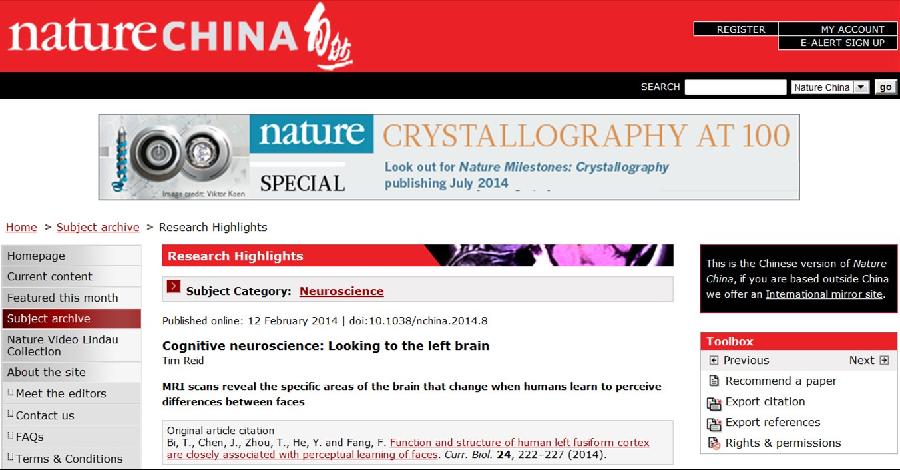Professor Fang Fang’s group recently published a paper titled “Function and structure of human left fusiform cortex are closely associated with perceptual learning of faces” in Current Biology (24(2), 222-227). In collaboration with Dr. Tiangang Zhou from the Chinese Academy of Sciences and Dr. Yong He from Beijing Normal University, they combined psychophysics, functional and anatomical magnetic resonance imaging (MRI), and used an experimental paradigm of face perceptual learning to study the neural plasticity of human visual system. Nature China highlighted this study on February 12th.
Neural plasticity refers to experience-induced functional and anatomical changes with individual neurons and neural circuits at multiple scales. Human brain is plastic throughout a lifetime. Perceptual learning is the phenomenon that training can lead to long-lasting improvement in our perceptual ability, which is a manifestation of neural plasticity and is also an excellent paradigm for studying neural plasticity. In the past decades, many psychophysical experiments have been performed to study perceptual learning and various theories have been proposed to explain the psychophysical findings. However, due to the paucity of neurophysiological and brain imaging data, we still know little about the neural mechanisms of perceptual learning. In this study, with fMRI and aMRI, Professor Fang’s group addressed this issue by searching for the neural correlates of perceptual learning of face views over a long time course. Human subjects were trained to perform a face view discrimination task. Their behavioral performance and MRI signals were measured before, immediately after, and one month after training. It was found that, across individual subjects, their behavioral learning effects correlated with the stability improvement of spatial activity pattern in the left fusiform cortex immediately after and one month after training. It was also found that the thickness of the left fusiform cortex before training could predict subjects’ behavioral learning effects. These findings, for the first time, not only suggest that the improved pattern stability remarkably contributes to the long-term mechanisms of perceptual learning, but also provide strong and converging evidence for the pivotal role of the left fusiform cortex in adaptive face processing. These finding also shed new light on the general mechanisms of brain plasticity.
The study was supported by the Ministry of Science and
Technology, the National Natural Science Foundation of China, the
Peking-Tsinghua Center for Life Sciences and the IDG/McGovern
Institute for Brain Research.